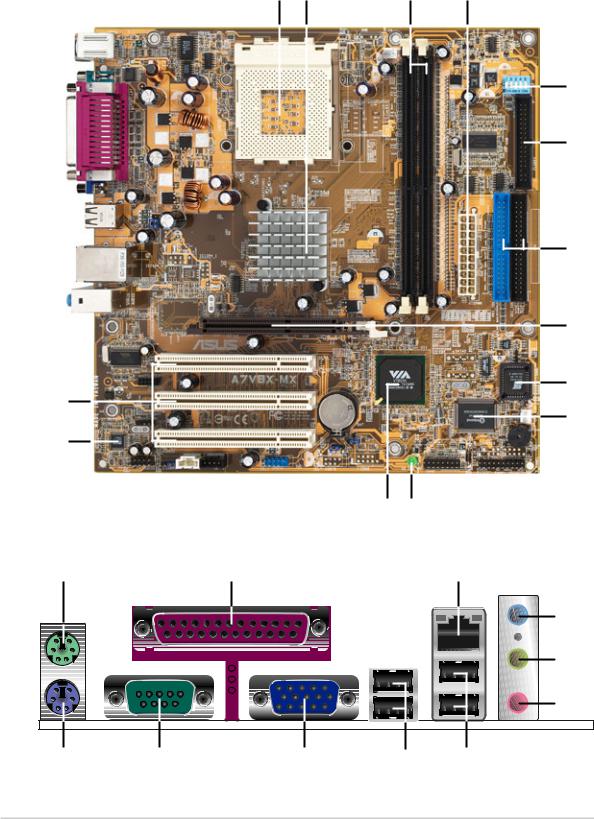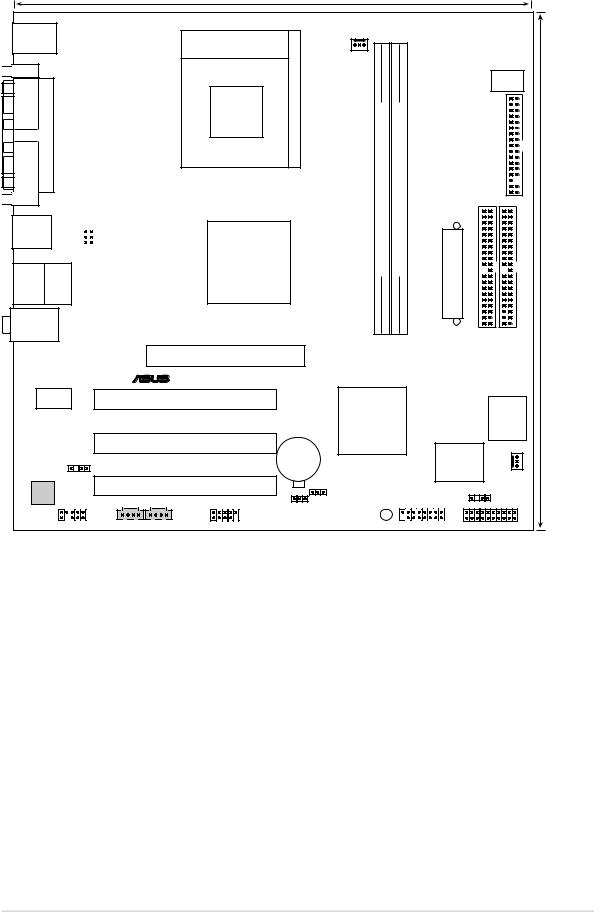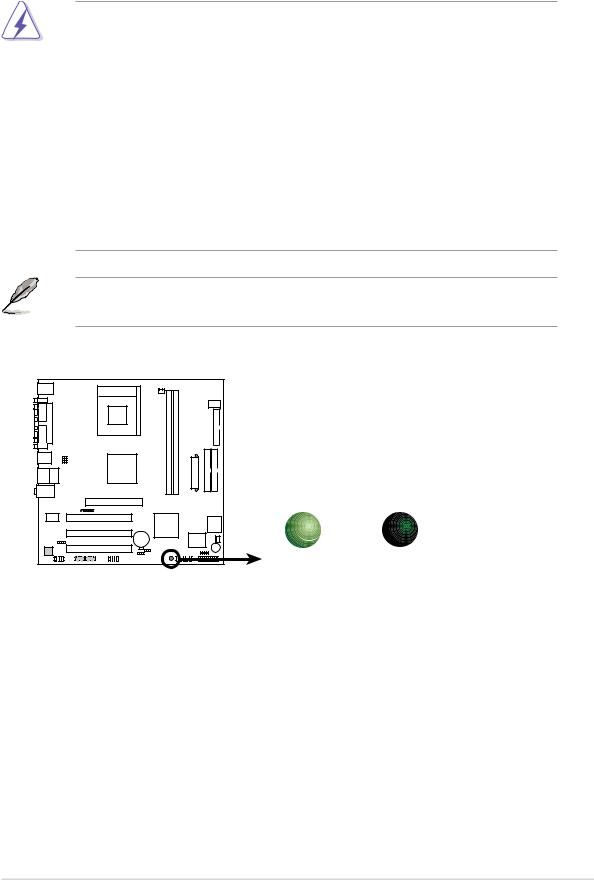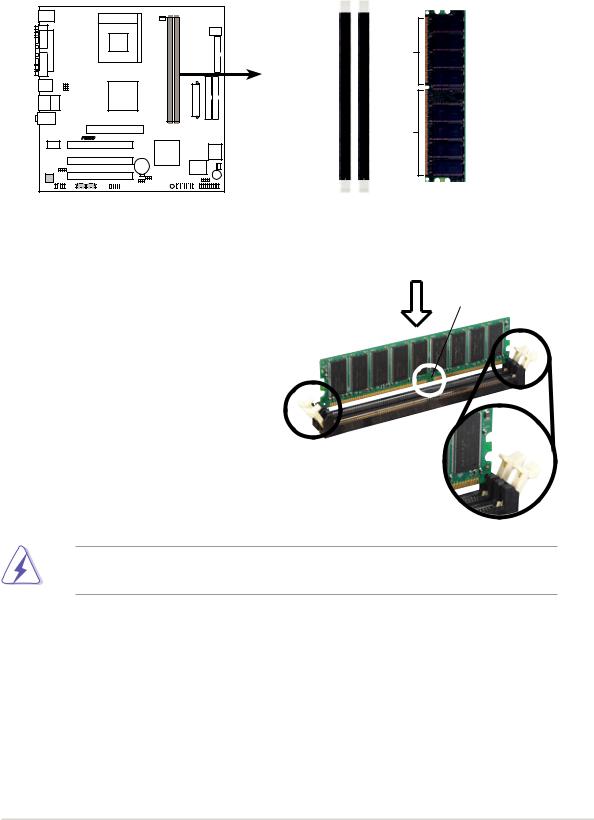ASUS A7V8X-MX User Manual

A7V8X-MX
User Manual
Motherboard

E1397
Revised Edition V3
August 2003
Copyright © 2003 ASUSTeK COMPUTER INC. All Rights Reserved.
No part of this manual, including the products and software described in it, may be reproduced, transmitted, transcribed, stored in a retrieval system, or translated into any language in any form or by any means, except documentation kept by the purchaser for backup purposes, without the express written permission of ASUSTeK COMPUTER INC. (“ASUS”).
Product warranty or service will not be extended if: (1) the product is repaired, modified or altered, unless such repair, modification of alteration is authorized in writing by ASUS; or (2) the serial number of the product is defaced or missing.
ASUS PROVIDES THIS MANUAL “AS IS” WITHOUT WARRANTY OF ANY KIND, EITHER EXPRESS OR IMPLIED, INCLUDING BUT NOT LIMITED TO THE IMPLIED WARRANTIES OR CONDITIONS OF MERCHANTABILITY OR FITNESS FOR A PARTICULAR PURPOSE. IN NO EVENT SHALL ASUS, ITS DIRECTORS, OFFICERS, EMPLOYEES OR AGENTS BE LIABLE FOR ANY INDIRECT, SPECIAL, INCIDENTAL, OR CONSEQUENTIAL DAMAGES (INCLUDING DAMAGES FOR LOSS OF PROFITS, LOSS OF BUSINESS, LOSS OF USE OR DATA, INTERRUPTION OF BUSINESS AND THE LIKE), EVEN IF ASUS HAS BEEN ADVISED OF THE POSSIBILITY OF SUCH DAMAGES ARISING FROM ANY DEFECT OR ERROR IN THIS MANUAL OR PRODUCT.
SPECIFICATIONS AND INFORMATION CONTAINED IN THIS MANUAL ARE FURNISHED FOR INFORMATIONAL USE ONLY, AND ARE SUBJECT TO CHANGE AT ANY TIME WITHOUT NOTICE, AND SHOULD NOT BE CONSTRUED AS A COMMITMENT BY ASUS. ASUS ASSUMES NO RESPONSIBILITY OR LIABILITY FOR ANY ERRORS OR INACCURACIES THAT MAY APPEAR IN THIS MANUAL, INCLUDING THE PRODUCTS AND SOFTWARE DESCRIBED IN IT.
Products and corporate names appearing in this manual may or may not be registered trademarks or copyrights of their respective companies, and are used only for identification or explanation and to the owners’ benefit, without intent to infringe.
ii
Contents
Notices ....................................................................................................... |
vi |
Safety information ....................................................................................... |
v |
ASUS contact information .......................................................................... |
vi |
A7V8X-MX specifications summary ........................................................... |
vii |
About this manual ..................................................................................... |
viii |
Chapter 1 - Motherboard Info
1.1 |
Welcome! ....................................................................................... |
1-2 |
|
1.2 |
Package contents .......................................................................... |
1-2 |
|
1.3 |
Special features ............................................................................. |
1-2 |
|
1.4 |
Motherboard components .............................................................. |
1-4 |
|
1.5 |
Motherboard layout ........................................................................ |
1-7 |
|
1.6 |
Motherboard installation ................................................................ |
1-8 |
|
|
1.6.1 |
Placement direction ......................................................... |
1-8 |
|
1.6.2 |
Screw holes ..................................................................... |
1-8 |
1.7 |
Before you proceed ....................................................................... |
1-9 |
|
1.8 |
Central Processing Unit (CPU) .................................................... |
1-10 |
|
|
1.8.2 |
Installing the CPU .......................................................... |
1-10 |
1.9 |
System memory ........................................................................... |
1-11 |
|
|
1.9.1 |
Installing a DIMM ........................................................... |
1-11 |
1.10 |
Expansion slots ........................................................................... |
1-12 |
|
|
1.10.1 |
Configuring an expansion card ...................................... |
1-12 |
|
1.10.2 |
Standard Interrupt Assignments .................................... |
1-12 |
|
1.10.3 |
AGP slot ......................................................................... |
1-13 |
|
1.10.4 |
PCI slots ........................................................................ |
1-13 |
1.11 |
Switch and jumpers ..................................................................... |
1-14 |
|
1.12 |
Connectors .................................................................................. |
1-17 |
|
Chapter 2 - BIOS Information
2.1 |
Managing and updating your BIOS ............................................... |
2-2 |
|
|
2.1.1 |
Creating a bootable floppy disk ....................................... |
2-2 |
|
2.1.2 |
Updating BIOS using the AwardBIOS Flash Utility .......... |
2-3 |
|
2.1.3 |
CrashFree BIOS feature .................................................. |
2-4 |
2.2 |
BIOS beep codes .......................................................................... |
2-5 |
|
2.3 |
BIOS Setup program ..................................................................... |
2-5 |
|
|
2-2.3.1 |
BIOS menu bar ................................................................ |
2-6 |
|
2.3.2 |
Legend bar ....................................................................... |
2-6 |
2.4 |
Main Menu ..................................................................................... |
2-8 |
|
2.4.1IDE Primary Master/Slave
|
IDE Secondary Master/Slave ......................................... |
2-10 |
2.5 Advanced Menu ........................................................................... |
2-12 |
|
2.5.1 |
Chip Configuration ......................................................... |
2-13 |
2.5.2 |
I/O Device Configuration ................................................ |
2-18 |
|
|
|
iii

Contents
|
2.5.3 |
PCI Configuration .......................................................... |
2-20 |
2.6 |
Power Menu ................................................................................ |
2-22 |
|
|
2.6.1 |
Power Up Control .......................................................... |
2-24 |
|
2.6.2 |
Hardware Monitor .......................................................... |
2-25 |
2.7 |
Boot Menu ................................................................................... |
2-26 |
|
2.8 |
Exit Menu ..................................................................................... |
2-27 |
|
Chapter 3 Software support
3.1 |
Installing an operating system ....................................................... |
3-2 |
|
3.2 |
Support CD information ................................................................. |
3-2 |
|
|
3.2.1 Running the support CD .................................................. |
3-2 |
|
|
3.2.2 |
Drivers menu ................................................................... |
3-3 |
|
3.2.3 |
Utilities menu ................................................................... |
3-4 |
|
3.2.4 |
ASUS Contact Information ............................................... |
3-5 |
Notices
Federal Communications Commission Statement
This device complies with FCC Rules Part 15. Operation is subject to the following two conditions:
•This device may not cause harmful interference, and
•This device must accept any interference received including interference that may cause undesired operation.
This equipment has been tested and found to comply with the limits for a Class B digital device, pursuant to Part 15 of the FCC Rules. These limits are designed to provide reasonable protection against harmful interference in a residential installation. This equipment generates, uses and can radiate radio frequency energy and, if not installed and used in accordance with manufacturer’s instructions, may cause harmful interference to radio communications. However, there is no guarantee that interference will not occur in a particular installation. If this equipment does cause harmful interference to radio or television reception, which can be determined by turning the equipment off and on, the user is encouraged to try to correct the interference by one or more of the following measures:
•Reorient or relocate the receiving antenna.
•Increase the separation between the equipment and receiver.
•Connect the equipment to an outlet on a circuit different from that to which the receiver is connected.
•Consult the dealer or an experienced radio/TV technician for help.
The use of shielded cables for connection of the monitor to the graphics card is required to assure compliance with FCC regulations. Changes or modifications to this unit not expressly approved by the party responsible for compliance could void the user’s authority to operate this equipment.
iv

Canadian Department of Communications Statement
This digital apparatus does not exceed the Class B limits for radio noise emissions from digital apparatus set out in the Radio Interference Regulations of the Canadian Department of Communications.
This class B digital apparatus complies with Canadian ICES-003.
Safety information
Electrical safety
•To prevent electrical shock hazard, disconnect the power cable from the electrical outlet before relocating the system.
•When adding or removing devices to or from the system, ensure that the power cables for the devices are unplugged before the signal cables are connected. If possible, disconnect all power cables from the existing system before you add a device.
•Before connecting or removing signal cables from the motherboard, ensure that all power cables are unplugged.
•Seek professional assistance before using an adpater or extension cord. These devices could interrupt the grounding circuit.
•Make sure that your power supply is set to the correct voltage in your area. If you are not sure about the voltage of the electrical outlet you are using, contact your local power company.
•If the power supply is broken, do not try to fix it by yourself. Contact a qualified service technician or your retailer.
Operation safety
•Before installing the motherboard and adding devices on it, carefully read all the manuals that came with the package.
•Before using the product, make sure all cables are correctly connected and the power cables are not damaged. If you detect any damage, contact your dealer immediately.
•To avoid short circuits, keep paper clips, screws, and staples away from connectors, slots, sockets and circuitry.
•Avoid dust, humidity, and temperature extremes. Do not place the product in any area where it may become wet.
•Place the product on a stable surface.
•If you encounter technical problems with the product, contact a qualified service technician or your retailer.
v

ASUS contact information
ASUSTeK COMPUTER INC. (Asia-Pacific)
Address: |
150 Li-Te Road, Peitou, Taipei, Taiwan 112 |
General Tel: |
+886-2-2894-3447 |
General Fax: |
+886-2-2894-3449 |
General Email: |
info@asus.com.tw |
Technical Support
MB/Optical Drives (Tel): +886-2-2890-7121 (English)
Notebook (Tel): |
+886-2-2890-7122 (English) |
Desktop/Server (Tel): |
+886-2-2890-7123 (English) |
Support Fax: |
+886-2-2890-7698 |
Web Site: |
www.asus.com.tw |
ASUS COMPUTER INTERNATIONAL (America)
Address: |
44370 Nobel Drive, Fremont, CA 94538, USA |
General Fax: |
+1-502-933-8713 |
General Email: |
tmd1@asus.com |
Web Site: |
usa.asus.com |
Technical Support
Support Fax: |
+1-502-933-8713 |
General Support: |
+1-502-995-0883 |
Notebook Support: |
+1-877-918-ASUS (2787) |
Support Email: |
tsd@asus.com |
ASUS COMPUTER GmbH (Germany and Austria)
Address: |
Harkort Str. 25, D-40880 Ratingen, Germany |
Website Address |
www.asuscom.de |
Online Contact: |
www.asuscom.de/sales |
Telephone: |
+49-2102-95990 |
General Fax: |
+49-2102-959911 |
Technical Support
Component Support: |
+49-2102-95990 |
Notebook Support: |
+49-2102-959910 |
Support Fax: |
+49-2102-959911 |
Online Support: |
www.asuscom.de/support |
vi

A7V8X-MX specifications summary
CPU
Chipset
Front Side Bus (FSB)
Memory
Expansion slots
IDE
Graphics
Audio
LAN
Hardware Monitoring
Back Panel I/O Ports
Internal I/O
Connectors
BIOS features
Socket A for AMD Athlon™XP up to 3200+ processor Thoroughbred/Barton core support
VIA KM400
VIA VT8235 CE
333/266/200 MHz
2 x 184-pin DDR DIMM sockets support up to maximum 2 GB unbuffered PC2700/2100/1600 non-ECC DDR SDRAM memory.
3 x PCI
1 x AGP 8X/4X (0.8V or 1.5V only)
2 x UltraATA133/100/66/33
Integrated VIA UniChrome™ Graphics
AD1980 6-channel AUDIO CODEC
S/PDIF out interface
VIA VT6103 10/100 Mbps Ethernet PHY
Super I/O integrated monitoring of CPU/chassis fan and MB/CPU temperature
1 x Parallel
1 x Serial (COM1)
1 x PS/2 Keyboard
1 x PS/2 Mouse
1 x RJ45 port
1 x Audio I/O
1 x VGA port
4 x USB 2.0/1.1
1 x USB connector supports additional 2 USB 2.0 ports CPU/chassis FAN connectors
Chassis intrusion connector 20-pin ATX power connector PANEL connector
CD / AUX connectors S/PDIF out connector GAME/MIDI connector Front panel audio connector
2Mb Flash EEPROM, Award BIOS, ACPI, DMI2.0, PnP features, TCAV, CrashFree BIOS
(continued next page)
vii

A7V8X-MX specifications summary
Industry standard |
PCI 2.2, USB 2.0/1.1 |
Manageability |
|
WOL, WOR, chassis intrusion |
|
Support CD contents |
|
Device drivers |
|
|
ASUS PC Probe |
|
ASUS Screensaver |
|
Award BIOS Flash Utility |
|
Direct X |
|
Adobe Acrobat Reader |
|
Trend Micro™ PC-cillin 2002 |
Accessories |
|
User Manual |
|
|
ASUS A7V8X-MX support CD |
|
UltraATA cable |
|
FDD cable |
|
I/O shield |
Form Factor |
|
Micro-ATX form factor: 9.6 in x 9.6 in |
|
|
|
* Specifications are subject to change without notice.
About this manual
Conventions used in this guide
To make sure that you perform certain tasks properly, take note of the following symbols used throughout this manual.
WARNING: Information to prevent injury to yourself when trying to complete a task.
CAUTION: Information to prevent damage to the components when trying to complete a task.
IMPORTANT: Information that you MUST follow to complete a task.
NOTE: Tips and additional information to aid in completing a task.
viii

Chapter 1
This chapter describes the features of the A7V8X-MX motherboard. It includes brief descriptions of the motherboard components, and illustrations of the layout, jumper settings, and connectors.
Product introduction

1.1Welcome!
Thank you for buying the ASUS® A7V8X-MX motherboard!
The ASUS A7V8X-MX motherboard is loaded with the most advanced technologies to deliver maximum performance for Socket A processors. This motherboard is packed with value-added features for guaranteed consumer satisfaction. The following sections provide important technical information about the motherboard for future upgrades or system reconfiguration.
Before you start installing the motherboard and hardware devices on it, check the items in your package with the list below.
1.2Package contents
Check your ASUS A7V8X-MX package for the following items.
ASUS A7V8X-MX motherboard.(Micro-ATX form factor: 9.6 in x 9.6 in)
ASUS A7V8X-MX support CD
40-pin 80-conductor ribbon cable for UltraATA133/100/66/33 IDE drives
Ribbon cable for a 3.5-inch floppy drive
Bag of extra jumper caps
I/O shield
User Manual
1.3Special features
333MHz FSB support for Athlon™ XP processors
The A7V8X-MX motherboard supports 333MHz front side bus frequency for Athlon™ XP processors allowing increased application program productivity and enhanced digital media experience. See page 1-9 for details.
AGP 8X support
AGP 8X (AGP 3.0) is the next generation VGA interface specification that enables enhanced graphics performance with high bandwidth speeds of up to 2.12 GB/s. See details on page 1-13.
1-2 |
Chapter 1: Product Information |

Integrated Graphics
The A7V8X-MX motherboard is loaded with an integrated VIA Unichrome™ 2D/3D graphics core allowing efficient execution of multimedia applications and playback support for video and DVD.
SoundMAX Digital Audio System 
The SoundMax Digital Audio System is the industry’s highest performance and most reliable audio solution for business professionals, audiophiles, musicians, and gamers. SoundMAX Digital Audio System can output 5.1 channel surround and features state-of-the-art DLS2 MIDI synthesizer with Yamaha DLSbyXG sound set, 5.1 Virtual Theater™ and supports all major game audio technologies including Microsoft DirectX™8.0, Microsoft DirectSound 3D™, A3D, MacroFX, ZoomFX, MultiDrive 5.1 and EAX. See page 3-3
USB 2.0 technology 
The motherboard implements the Universal Serial Bus (USB) 2.0 specification, dramatically increasing the connection speed from the 12 Mbps bandwidth on USB 1.1 to a fast 480 Mbps on USB 2.0. USB 2.0 is backward compatible with USB 1.1.
ASUS C.O.P.
The ASUS C.O.P. (CPU Overheating Protection) is a hardware protection circuit that automatically shuts down the system power before temperatures go high enough to permanently damage the CPU. See page 2-23.
ASUS CrashFree BIOS 
CrashFree BIOS allows users to restore BIOS data from a floppy disk even when BIOS code and data are corrupted. Users can now enjoy this feature without the need to buy a new ROM. See page 2-4 for details.
Digital audio support
A Sony/Philips Digital Interface (S/PDIF) connector is onboard to give you convenient connectivity to external home theater audio systems. The S/PDIF technology allows direct digital audio transfers keeping the best signal quality. NOTE: The S/PDIF module is purchased separately.
Integrated 10/100 LAN 
The A7V8X-MX motherboard is equipped with an onboard 10/100Mbps Fast Ethernet controller to give you a fast and reliable connection to Local Area Networks (LANs) and the Internet.
ASUS A7V8X-MX motherboard user manual |
1-3 |

1.4Motherboard components
Before you install the motherboard, learn about its major components and available features to facilitate the installation and future upgrades. Refer to the succeeding pages for the component descriptions.
1 |
2 |
3 |
4 |
5
6
7
8
9
14
10
13
12 11
15 |
16 |
17 |
18 |
19 |
20 |
25 |
24 |
23 |
22 |
21 |
1-4 |
Chapter 1: Product Information |

1CPU Socket. Socket 462 (Socket A) Zero Insertion Force (ZIF) socket for AMD Athlon XP™ up to 3200+ processors.
2NorthBridge Controller. The VIA KM400 North Bridge controller chipset supports a 64-bit DDR memory controller and up to 2 GB of 333/266/ 200MHz DDR memory. It also incorporates the fast HyperTransport™ link to the CPU and supports AGP 8X technology. VIA KM400 is also loaded with the VIA UniChrome™ 2D/3D graphics core for efficient multimedia applications including DVD and video playback support.
3DDR DIMM Sockets. Equipped with two Double Data Rate Dual Inline Memory Module (DDR DIMM) sockets to support up to 2GB of DDR SDRAM, the newest memory standard with the highest bandwidth and lowest latency currently available. This memory technology supplies allows data transfer rates of up to 2.7 GB/s on 333MHz DDR SDRAM.
4ATX power connector. This standard 20-pin connector connects to an ATX 12V power supply. The power supply must have at least 1A on the +5V standby lead (+5VSB).
5DIP switches. This 5-pin Dual Inline Package (DIP) switches allows you to select the CPU frequency multiple.
6Floppy Disk connector. This connector connects the provided ribbon cable for the floppy disk drive. One side of the connector is slotted to prevent incorrect insertion of the floppy disk cable.
7IDE Connectors. These dual-channel bus master IDE connectors support up to four UltraATA133/100/66/33, PIO Modes 0-4 IDE devices. Both the primary(blue) and secondary(black) connectors are slotted to prevent incorrect insertion of the IDE ribbon cable.
8AGP Slot. The Accelerated Graphics Port (AGP) slot only supports 1.5V and 0.8V AGP 8X/4X mode graphics cards for 3D graphical applications.
9Flash EEPROM. This 2Mb ISA chip contains the programmable BIOS program.
10Super I/O chipset. Winbond 83697HF I/O controller offers support for a variety of I/O functions. Provides two high-speed UART compatible serial ports and one parallel port with EPP and ECP capabilities. The Super I/O controller supports a floppy disk drive, Game/MIDI port, PS/2 keyboard, and PS/2 mouse.
11Onboard LED. This onboard LED lights up if there is a standby power on the motherboard. This LED acts as a reminder to turn off the system power before plugging or unplugging devices.
ASUS A7V8X-MX motherboard user manual |
1-5 |

12South bridge controller. The VIA VT8235 CE integrated peripheral South bridge controller communicates with the North bridge at rates of up to 533MB/s using the VIA 8X VLink Technology. The Southbridge controller provides efficient bandwith requirements for PCI, USB and support for LAN devices. The controller also supports standard UltraATA133/100/66/33 and provides separate data paths for each IDE channel for up to two IDE devices. The controller supports six USB ports, one LAN port and is PCI 2.2 compliant.
13Audio CODEC. The ADI AD1980 6-channel Audio CODEC is AC’97 compliant and is designed for PC multimedia systems.
14PCI slots. These 32-bit PCI 2.2 expansion slots support bus master PCI cards like SCSI and LAN cards with 133MB/s maximum output.
15PS/2 mouse port. This green 6-pin connector is for a PS/2 mouse.
16Parallel port. This 25-pin port connects a parallel printer, a scanner, or other devices.
17RJ-45 port. Using the South bridge integrated MAC and the VIA VT6103 LAN PHY Fast Ethernet controller, this port allows connection to a Local Area Network (LAN) through a network hub.
18Line In jack. This Line In (light blue) jack connects a tape player or other audio sources. In a 6-channel mode, this jack functions as Bass/Center.
19Line Out jack. This Line Out (lime) jack connects a headphone or a speaker. In a 6-channel mode, this jack functions as Front Speaker Out.
20Microphone jack. This Mic (pink) jack connects a microphone. In a 6-channel mode, this jack functions as Rear Speaker Out.
21USB 1 & 2 ports. These two 4-pin Universal Serial Bus 2.0/1.1 ports are available for connecting USB devices such as mouse and PDA.
22USB 3 & 4 ports. These two 4-pin Universal Serial Bus 2.0/1.1 ports are available for connecting USB devices such as mouse and PDA.
23VGA port. This 15-pin VGA port connects to a VGA monitor.
24Serial port (COM1). This port connects to your serial mouse and other serial devices.
25PS/2 keyboard port. This purple 6-pin connector is for a PS/2 keyboard.
1-6 |
Chapter 1: Product Information |

1.5Motherboard layout
24.5cm (9.6in)
PS/2KBMS
T: Mouse
B: Keyboard

 COM1
COM1
Socket 462
CPU_FAN
DSW

 VGA1
VGA1
USB1
USB2
PARALLEL PORT
USBPWR34 |
|
|
USBPWR12 |
|
|
||
|
|
||
|
|
USB2.0 Top: T: USB3 RJ-45 B: USB4
Top:Line In
VIA
KM400
Chipset
bit,184-pin module) |
bit,184-pin module) |
|
FLOPPY |
DDR DIMM1 (64 |
DDR DIMM2 (64 |
ATX Power Connector |
24.5cm (9.6in) |
Center:Line Out
Below:Mic In |
|
|
|
|
PRIIDE |
SECIDE |
|
|
Accelerated Graphics Port (AGP1) |
|
|
||
|
|
® |
|
|
|
|
VIA |
|
PCI1 |
VIA |
|
|
|
VT6103 |
|
|
2Mbit |
ISA chip |
||
|
|
A7V8X-MX |
VT8235CE |
|
||
|
|
South |
|
|||
|
|
PCI2 |
Bridge |
|
||
|
|
|
|
|
||
|
|
|
Super |
CHA_FAN1 |
||
|
|
CR2032 3V |
|
|
|
|
|
|
Lithium Cell |
|
|
|
|
SPDIF |
|
CMOS Power |
|
I/O |
|
|
|
|
|
|
|
||
AD1980 |
|
PCI3 |
CLRTC |
|
|
|
CODEC |
|
|
CHASSIS |
|
|
|
|
|
|
|
|
|
|
|
|
USBPWR56 |
|
|
|
|
FP_AUDIO |
|
USB56 |
|
|
|
|
AUX1 |
CD1 |
SB_PWR |
GAME |
PANEL |
||
ASUS A7V8X-MX motherboard user manual |
1-7 |

1.6Motherboard installation
The A7V8X-MX uses the Micro ATX form factor, measuring 24.5 cm (9.6 in.) x 24.5 cm (9.6 in.) - a standard fit for most large chassis.
WARNING! Unplug the power cord before installing the motherboard. Failure to do so may cause you physical injury and damage Motherboard components.
1.6.1 Placement direction
When installing the motherboard, take care to orient the chassis correctly: The edge with external ports goes to the rear part of the chassis. Refer to the image below. It may be more convenient to install major cables, the CPU and modular components before fixing the motherboard inside the case frame.
1.6.2 Screw holes
Place eight (8) screws into the holes indicated by circles to secure the motherboard to the chassis.
Do not overtighten the screws! Doing so may damage the motherboard.
Place this side towards the rear of the chassis
1-8 |
Chapter 1: Product Information |

1.7Before you proceed
Take note of the following precautions before you install motherboard components or change any motherboard settings.
1.Unplug the power cord from the wall socket before touching any component.
2.Use a grounded wrist strap or touch a safely grounded object or to a metal object, such as the power supply case, before handling components to avoid damaging them due to static electricity.
3.Avoid touching the ICs on components.
4.Whenever you uninstall any component, place it on a grounded antistatic pad or in the bag that came with the component.
5.Before you install or remove any component, ensure that the ATX power supply is switched off or the power cord is detached from the power supply. Failure to do so may cause severe damage to the motherboard, peripherals, and/or components.
When lit, the onboard LED indicates that the system is ON, in sleep mode or in soft-off mode, not powered OFF. See the illustration below.
A7V8X-MX |
SB_PWR
ON OFF
A7V8X-MX Onboard LED |
Standby |
Powered |
Power |
Off |
ASUS A7V8X-MX motherboard user manual |
1-9 |

1.8Central Processing Unit (CPU)
The motherboard provides a Socket A (462) for CPU installation. The A7V8X-MX supports Athlon™ XP processors with “QuantiSpeed” data processing, large data caches, 3D enhancements and 333/266/200MHz bus speeds. AMD Athlon™ XP processors offer gigahertz speeds to support all the latest computing platforms and applications
|
CPU NOTCH |
|
|
TO INNER |
|
|
CORNER |
|
|
|
LOCK |
|
|
LEVER |
A7V8X-MX |
AMD™ CPU |
CPU NOTCH |
|
|
|
A7V8X-MX Socket 462 |
|
|
Each AMD CPU has a “marked” corner. This corner is usually indicated with a notch, and/or a golden square or triangle. Refer to this indicator while orienting the CPU. A fan and heatsink should be attached to the CPU to prevent overheating.
1.8.2 Installing the CPU
Follow these steps to install a CPU:
1.Locate the Socket 462 and open it by pulling the lever gently sideways away from the socket. Then lift the lever upwards. The socket lever must be fully opened (90 to 100 degrees).
2.Insert the CPU with the correct orientation. The notched or golden corner of the CPU must be oriented toward the inner corner of the socket base nearest to the lever hinge.
The CPU should drop easily into place. Do not force the CPU into the socket to avoid bending the pins. If the CPU does not fit, check its alignment and look for bent pins.
1-10 |
Chapter 1: Product Information |

1.9System memory
The motherboard has two Double Data Rate (DDR) DIMM sockets that supports up to 2GB non-ECC PC2700/2100/1600 DDR SDRAM DIMMs. Each DIMM socket/module is two-sided. DIMMs come in combinations of single or doublesided types ranging through 64MB, 128MB, 256MB, 512MB and 1 GB.
A7V8X-MX |
A7V8X-MX 184-Pin DDR DIMM Sockets
104 Pins 80 Pins
DIMM1 |
DIMM2 |
1.9.1 Installing a DIMM
DDR DIMM notch
1.Unlock a DIMM socket by pressing the retaining clips outward.
2.Align a DIMM on the socket. Make sure the notches on the DIMM exactly match the notches in the socket.
3. Firmly insert the DIMM into the |
Unlocked Retaining Clip |
socket until the retaining clips lock |
|
into place. |
|
A DDR DIMM is keyed with a notch so that it fits in only one direction. DO NOT force a DIMM into a socket to avoid damaging the DIMM.
ASUS A7V8X-MX motherboard user manual |
1-11 |

1.10 Expansion slots
The A7V8X-MX motherboard has three (3) PCI and one (1) Accelerated Graphics Port (AGP). The following sub-sections describe the slots and the expansion cards that they support.
1.10.1 Configuring an expansion card
Some expansion cards need an IRQ to operate. Generally, an IRQ must be exclusively assigned to one function at a time. In a standard design configuration, 16 IRQs are available but most are already in use.
Normally, 6 IRQs are free for expansion cards. Sometimes IRQs are “shared” by more than one function; in this case, IRQ assignments are swapped automatically or adjusted through the BIOS firmware.
1.10.2 Standard Interrupt Assignments
IRQ |
Standard Function |
0 |
System Timer |
|
|
1 |
Keyboard Controller |
|
|
2 |
Programmable Interrupt Controller |
|
|
3* |
USB Universal Host Controller |
|
|
4* |
Communications Port (COM1) |
|
|
5* |
Onboard Audio |
|
|
6 |
Standard Floppy Disk Controller |
|
|
7* |
Printer Port (LPT1) |
|
|
8 |
System CMOS/Real Time Clock |
|
|
9* |
Onboard LAN |
|
|
10* |
USB Universal Host Controller |
|
|
11* |
Onboard VGA |
|
|
12* |
PS/2 Compatible Mouse Port |
|
|
13 |
Numeric Data Processor |
|
|
14* |
Ultra ATA Controller |
|
|
15* |
Secondary Ultra ATA Controller |
*These IRQs are usually available for ISA or PCI devices.
IRQ assignments for this motherboard
|
A |
B |
C |
D |
E |
F` |
G |
PCI slot 1 |
shared |
– |
– |
– |
– |
– |
– |
PCI slot 2 |
– |
shared |
– |
– |
– |
– |
– |
PCI slot 3 |
– |
– |
shared |
– |
– |
– |
– |
AGP slot |
shared |
– |
– |
– |
– |
– |
– |
1-12 |
Chapter 1: Product Information |
